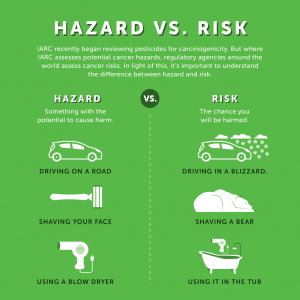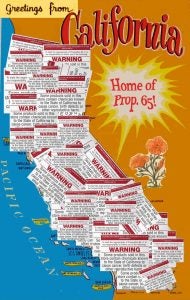Lately in the news of agriculture there has been a lot of controversy over the popular herbicide glyphosate being labeled as a carcinogen in California. According to peer-reviewed science it is not a carcinogen — with the exception of the IARC (International Agency on cancer research) aspect of the World Health Organization labeling it as a class 2A “possible carcinogen.” But should this be cause for concern?
As I’ve previously written about here, the IARC measures hazards, not risks. They claim pretty much everything causes cancer; from fishing poles, Disneyland, the sun and sunscreen, breathing air, drinking beer, eating bacon, playing cards, etc. Of all of the substances and activities they’ve measured, pretty much everything might give you cancer except for a chemical found in your toothbrush and yoga mat. It really is ridiculous, but has made lawyers a ton of money in the state of California.

Of course, the topic of cancer should never be taken lightly. But when every other agency claims glyphosate is in fact not carcinogenic to humans, one has to raise a skeptical eyebrow to the IARC. But to bring the skeptical bar up a notch, new information has risen to muddy the waters even further.
Aaron Blair, an epidemiologist from the U.S. cancer institute has seen some very important data that proved glyphosate had no link to cancer. But excuses were made as to why this data wasn’t considered. There have been many other studies, papers, reports and evidence that prove there is no link between cancer and humans when it comes to glyphosate. In fact, pretty much every other respected scientific organization will say that glyphosate has no effect on humans; it affects the EPSPS enzyme found in plants, not insects or mammals. To read further on this topic and the studies, read the full article by Reuters here, which also further explains the well-respected agricultural health study (AHS).
While the AHS deals with herbicides as it relates to actual real life in human exposure, the IARC seemed to have cherry picked their data from studies that relate more to rats. This is where it gets interesting. Apparently they did consider the famously discredited and retracted Seralini study in their findings to try to prove glyphosate might be a carcinogen. Say what now? The information provided by Seralini was totally laughable and is one of the most bogus “studies” in modern agricultural history. Google “Seralini debunked,” “Seralini retracted,” “Seralini bogus,” or anything else of the sort and you’ll see exactly what I’m talking about.
Seems incredibly fishy, doesn’t it? What is going on here? Well … I’m not sure. But I can say that the IARC is currently under investigation by Congress to dig in on who exactly is doing the funding for the IARC. And why does everything cause cancer in California? Who is behind prop 65 and this information? And why are these lawyers in California making so much money? Hmm …

Follow the money. As previously mentioned here, the $350 billion “natural” and “organic” industries are spending big bucks in lobbying dollars to create fear, doubt, and misleading information to try and sway the public and policy makers. They’ve also been caught paying hundreds of thousands of dollars to university professors like Chuck Benbrook to cherry pick data to line up with their agenda. While we can’t say for certain in every instance, politics and money always plays an influence on regulations and policies.
Doesn’t pretty much everything though? The media, politicians, corporate money, corruption … really does make the world go ’round for many different industries. However, what I can say as a farmer myself is that if you ask any of us why we use glyphosate, it is by far the safest herbicide we have ever had access to, which is a big reason why it’s so popular and available at any Home Depot or Walmart. If we wanted to boycott it, if we thought it was terrible and making us all sick, we would be the first ones to complain. Yet the bad science behind the IARC just doesn’t add up, especially when you compare it to the older more outdated herbicides of decades past. There is a reason why a lot of farmers use this product – it is very safe by comparison.
Unfortunately in any occupation, anyone can get cancer. But after looking at what studies were considered and which ones weren’t, after further looking at the money trail behind the cancer industry, the IARC, the lawyers involved, and the corruption, all I can say is … I smell a rat.
Michelle Miller, the Farm Babe, is an Iowa-based farmer, public speaker and writer, who lives and works with her boyfriend on their farm which consists of row crops, beef cattle, and sheep. She believes education is key in bridging the gap between farmers and consumers.



